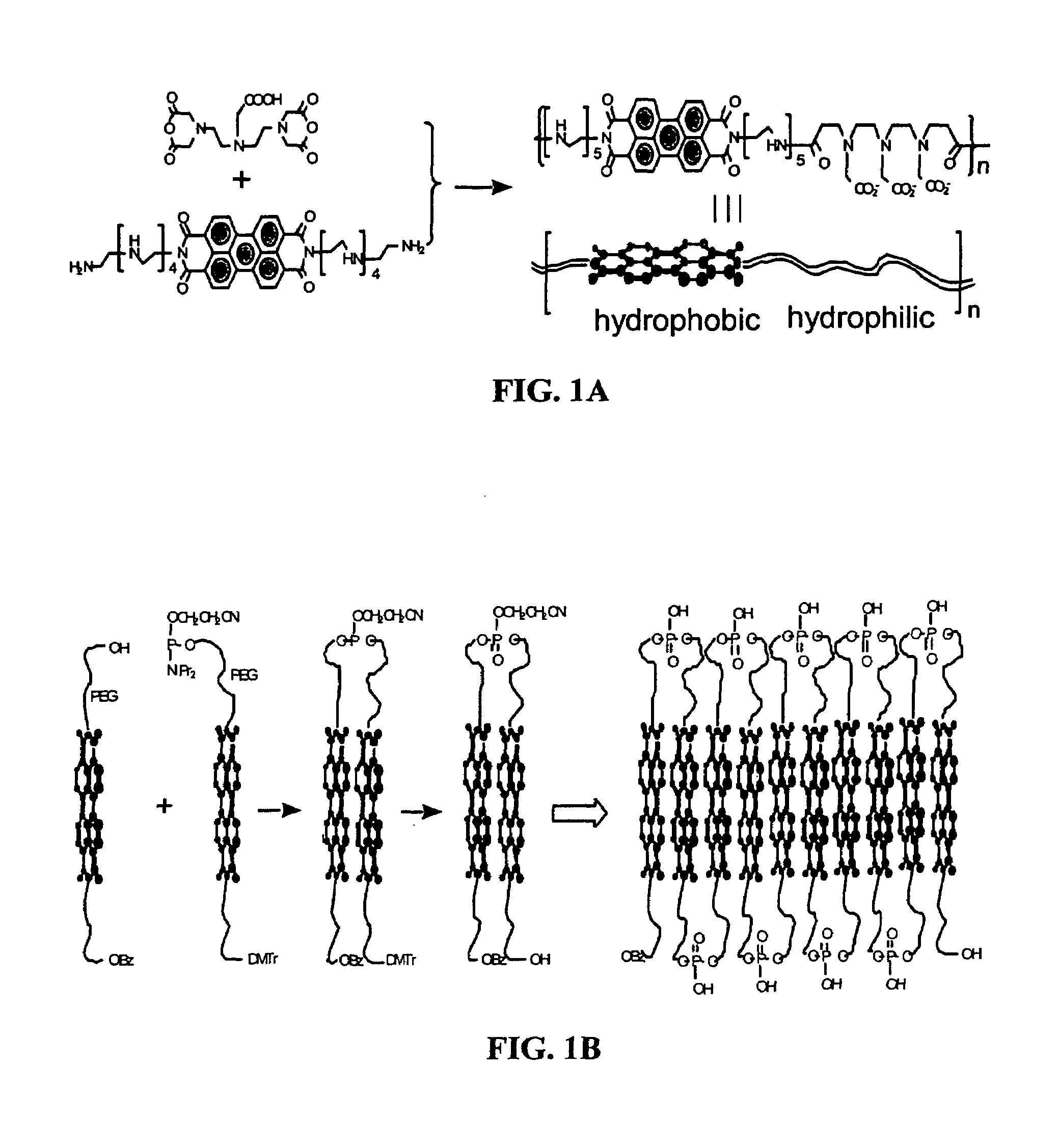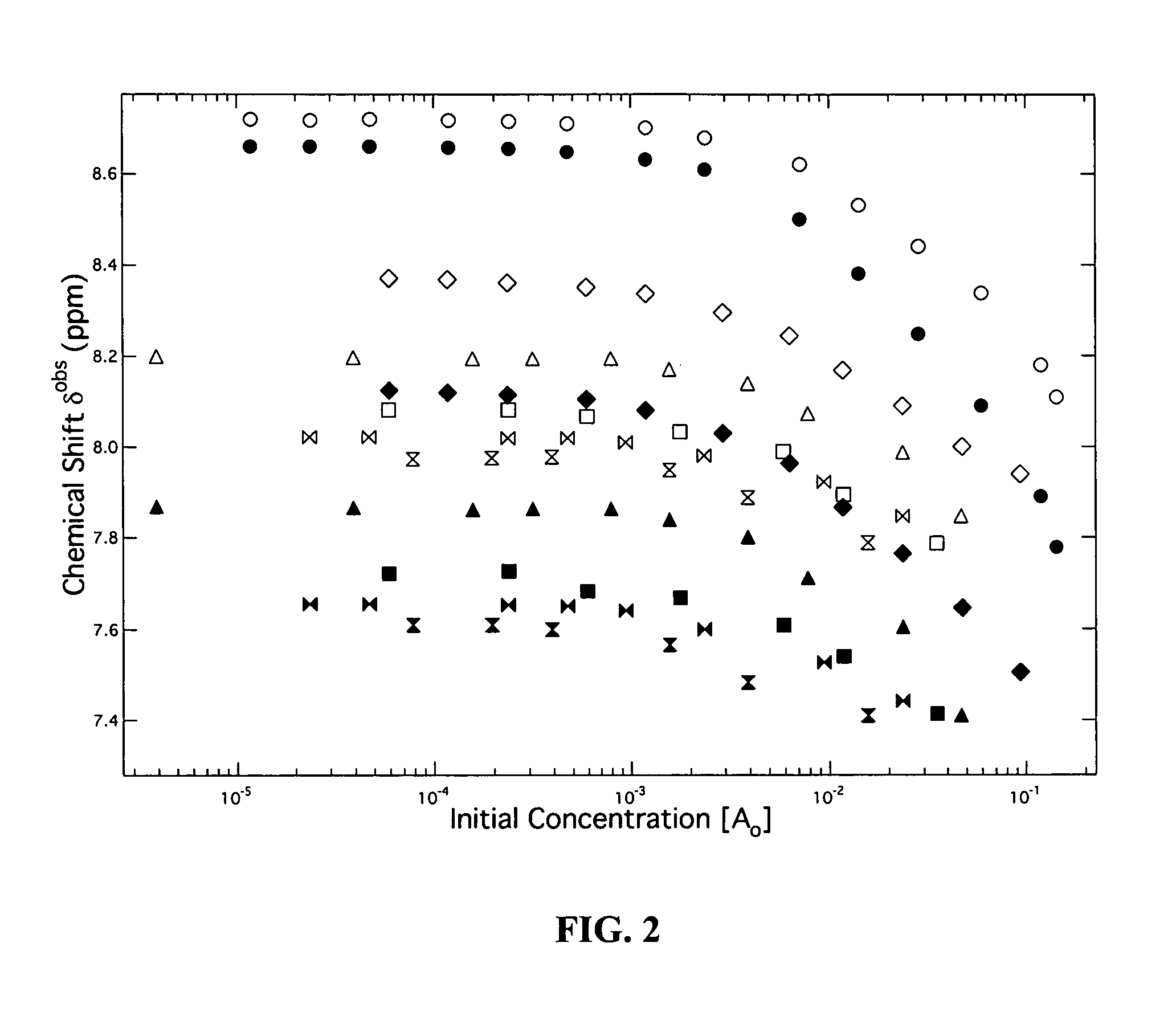Foldable polymers as probes
a polymer and probe technology, applied in the field of specific target molecules detection reagents and methods, can solve the problems of limited molecular beacons, no single method is universally applicable, and the detection of molecules using molecular recognition events other than complementary oligonucleotide hybridization is a more difficult proposition, so as to achieve simple on/off signals
- Summary
- Abstract
- Description
- Claims
- Application Information
AI Technical Summary
Benefits of technology
Problems solved by technology
Method used
Image
Examples
example 1
[0103]This example describes the preparation ofp-toluenesulfonic acid 2-[2-[2-(2-hydroxyethoxy)ethoxy]ethoxy]ethyl ester. To a solution of p-toluenesulfonyl chloride (22 g, 0.12 mol) in 200-mL dry CH2Cl2 (4 Å activated molecular sieves, 3 days) at 0° C., was added tetraethylene glycol (18 mL, 0.10 mol) and dry triethylamine (NaOH, pellets 3 days) (22 mL, 0.16 mol). The reaction mixture was then stirred for 2 h at 0° C., and left overnight at room temperature (RT) under argon. Detection of the products on TLC plates was accomplished using UV light or phosphomolybdic acid solution (10% PMA in EtOH). After elimination of the precipitate by filtration, the solution was evaporated under reduced pressure. The residue was purified by chromatography on a silica-gel column eluted with EtOAc / Hexane (80:20 to 100:0), and the desired product was obtained (12 g, 33% yield) as a colorless oil: Rf0.2 (EtOAc).
example 2
[0104]This example describes the preparation of 2-[2-[2-(2-azidoethoxy)ethoxy]ethoxy]ethanol. A solution of monotosyl tetraethylene glycol (6 g, 17.2 mmol) and sodium azide (1.7 g, 26.2 mmol) in 50 mL of acetonitrile was heated under reflux (at 100° C. oil bath) for 36 hrs. After return to RT, 50 mL of water was added and the mixture was extracted with CH2Cl2. Detection of the products on TLC plates was accomplished using sulfuric acid solution (25.0 mL of conc. sulfuric acid, 12.6 g of ammonium molybdate, 0.57 g of cerium sulfate, and 225.0 mL of deionized water). The organic phase was then dried on MgSO4 and concentrated under reduced pressure. The residue was chromatographed on a silica-gel column eluted with EtOAc. The product was obtained as a colorless oil (3.3 g, 89% yield): Rf0.5 (EtOAc); 1H-NMR (CDCl3) δ3.77–3.59 (m, 14H, CH2OCH2, HOCH2), 3.40 (t, J=5.0 Hz, 2H, CH2N3).
example 3
[0105]This example describes the transformation of the azide product from example 2 to 2-[2-[2-(2-aminoethoxy)ethoxy]ethoxy]ethanol. The azido product from example 2 (3.3 g, 15.1 mmol), triphenylphosphine (4.4 g, 16.8 mmol), and water (405 mg, 22.5 mmol) were mixed with 20-mL THF. After the solution was stirred for 4 hrs. at RT, the solvent was eliminated under reduced pressure and the residual product was purified on a silica-gel column that was eluted with CHCl3 / CH3OH / Et3N (3:3:1). The desired compound was obtained as colorless oil (2.5 g, 86% yield): Rf0.4 (CHCl3 / CH3OH / Et3N, 3:3:1). Detection of the products on TLC plates was accomplished using a sulfuric acid solution (25.0 mL of conc. sulfuric acid, 12.6 g of ammonium molybdate, 0.57 g of cerium sulfate, and 225.0 mL of deionized water) and / or ninhydrin test solution (a mixture of solution i, ii, and iii: (i) 1 mL of 0.1 M aqueous potassium cyanide diluted to 50 mL with pyridine; (ii) 2.5 g of ninhydrin in 50 mL of ethanol; (ii...
PUM
| Property | Measurement | Unit |
|---|---|---|
| temperature | aaaaa | aaaaa |
| wavelength | aaaaa | aaaaa |
| wavelength | aaaaa | aaaaa |
Abstract
Description
Claims
Application Information
 Login to View More
Login to View More - R&D
- Intellectual Property
- Life Sciences
- Materials
- Tech Scout
- Unparalleled Data Quality
- Higher Quality Content
- 60% Fewer Hallucinations
Browse by: Latest US Patents, China's latest patents, Technical Efficacy Thesaurus, Application Domain, Technology Topic, Popular Technical Reports.
© 2025 PatSnap. All rights reserved.Legal|Privacy policy|Modern Slavery Act Transparency Statement|Sitemap|About US| Contact US: help@patsnap.com



